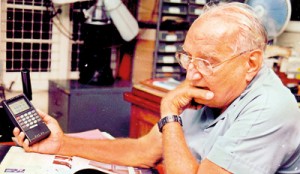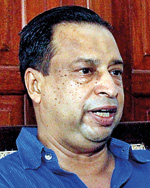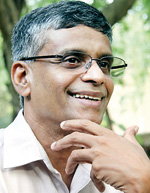Remembering the thinker and tinkerer
Deepal Sooriyaarachchi, Chairman of the panel of judges of the Ray Award remembers first spying Ray Wijewardene across the room with a sense of nostalgia. Sooriyaarachchi was delivering a lecture–one of his first as a young marketer back in the day–and he was stunned to note the senior, accomplished Wijewardene taking down meticulous notes in the audience. “That’s just the kind of person Ray was,” he says. “He never stopped learning, never stopped absorbing.”

Ray Wijewardene: An unquenchable thirst for learning
Ray Wijewardene needs little introduction. His Wikipedia page will tell you that he was an “engineer, aviator, inventor and Olympian athlete”; but to those who knew him, Ray was a man with immense personal charm, a man who saw the world and thought ‘why not?’ instead of ‘why?’ and a man who was “not just a thinker” say his daughters “but also a tinkerer” encouraging many. His interest in tropical farming in particular led to the design of the two-wheeled hand tractor in 1955; the invention changed the scope of farming, and was soon mass produced by Landmaster in Nottingham, UK. While this is Ray’s most famous contribution to date (alongside the light aircraft he built with motor engines as a hobby) his other accomplishments are testament to a life lived to the fullest.
In celebration of his life, accomplishments and legacy, but more so to honour his lifelong passion for invention, the Wijewardene family set up the Ray Wijewardene Charitable Trust in 2011 following his death at the age of 85 in 2010. The Trust commemorates Ray’s life in many ways, most notably with the annual memorial lecture which has seen speakers such as Dr. Anil Gupta on grassroots innovations and Professor Chandra Wickramasinghe on extra-terrestrial life take the stage.

Prof Malik Ranasinghe
While the Trust primarily aims to encourage and support innovation in sustainable agriculture, renewable energy, engineering and aeronautics, the Ray is awarded once every three years to recognize a Sri Lankan inventor and support them in commercializing their invention. To do so, they work in partnership with the Sri Lanka Inventors Commission, the University of Moratuwa (which provides technical support) and the Commercial Bank, which awards a grant of Rs. One Million to the winner.
“In Sri Lanka the problem is not the lack of inventors,” says Professor Malik Ranasinghe, a Trustee. “It has more to do with a lack of knowledge or infrastructure to take the invention and make it into something that can generate revenue and make an impact.” This is a sentiment echoed by Deepal Sooriyaarachchi. “Access to market, capital and technology is vital and that’s something many inventors in Sri Lanka struggle with. Economic factors and exposure to the right elements is also quite important,” he emphasises.
Wijewardene, for example, was privileged in a way that few of his fellow inventors were (or are). He grew up in Colombo and studied at S. Thomas’ College Mount Lavinia, moving on to Peterhouse College, University of Cambridge in the UK. Here he studied three branches of engineering-aeronautical, mechanical and agricultural-also qualifying as a Chartered Engineer in both the UK and Sri Lanka and studying business at the Harvard Business School. Undeniably, Wijewardene’s brilliance at what he did played the major role but circumstance also worked in his favour and that’s a factor missing from the lives of a significant number of inventors in the country.

Deepal Sooriyaarachchi
The Ray aims to encourage not just invention, but also innovation. In fact the latter plays a more significant role when it comes to the shortlisting and selection of winners. “Our aim is to help innovate inventions,” notes Prof. Ranasinghe. “That means that an invention-which is really just the first stage-is taken to the prototype stage where it becomes more feasible, can be demonstrated and has potential to be produced on a mass scale.” To qualify for the Ray Award the invention must have won a Presidential Award for invention (inventions may be from a few years back but must still be relevant) and must also have a patent-this way, “we have a smaller, more talented pool to choose from” says Prof. Ranasinghe “and there is credibility to the judging process.”
The panel of judges come from a vibrant array of fields, all the better to appreciate the different aspects of an invention. The judges shortlist inventors from a pool of applicants based on three factors; the soundness of the invention (can it stand the test of science and practicality?), its commercial potential and very simply its “wow factor”, smiles Mr. Sooriyaarachchi. “An invention has to make you pause for a minute, just to appreciate its capacity to change how we do things.” The commercial aspect also plays a significant role in the adjudication process, he notes. “Sometimes an invention can be both practical and useful but it has to be something that people would pay money for. It has to be marketable.”
The award was introduced for the first time in 2012, and the response was an indicator of the strength of invention in Sri Lanka. The judging panel shortlisted six applicants, who invented things like a surge diverter with unlimited capacity, a pneumatic self-retaining abdominal retractor and a wastage minimizing coir machine. It was I.S.W. Karunatilake, with his eco-friendly waveless boat design, who walked away with the Ray.
Winning the Ray proved to be the break Karunatilake badly needed. “This was a lifetime award for me,” he tells us. “It opened a lot of doors.” The boat was built from the Rs. One Million prize he received as the winner of the Ray from Commercial Bank. While the Trust does not stipulate that winners use the grant exclusively for their invention (“inventors accrue so much debt that it seemed unfair to make that stipulation,” Prof Ranasinghe had explained earlier) Karunatilake felt that the money would be better spent on developing an improved model of his invention. “It’s not an easy thing to be an inventor in this country,” he says. “For a long time I couldn’t take my work to the next level so the grant was very helpful in that way.”
However, the environment for innovation in Sri Lanka remains unfriendly, he says. “It has been very difficult to obtain a loan to manufacture the boat and actually put it into the market. Banks are unwilling to give loans so I will have to find another source of investment.” He also hopes to use the boat more commercially (it already does trips up and down the Kalu Ganga) at the Beira, but only time will tell. At present Karunatilake runs a manufacturing business, and he continues to invent little things to make his life easier. “Just the other day I was in hospital and couldn’t charge my phone,” he laughs. “That got me thinking-so I’ve come up with a new way to charge it when you’re on the go.”
This spirit of constant thinking and innovation is exactly what Wijewardene’s daughters hoped for when they introduced the award. “Ray’s mind was continually enquiring and exploring,” they say. “Our late father inspired many from all walks of life … and encouraged many youngsters to think out of the box. This award is really for them. Today, many of these people whom he inspired and mentored run their own businesses, applying his fine engineering techniques and above all, his ethos of passion and perseverance; and taking pride in one’s work and never losing heart.”
Ray Awards Shortlist for 2015
| |


